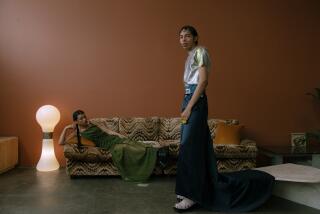New legs for an old motif
- Share via
THE latest design revival celebrates one of the most elemental motifs in furniture: animal legs and feet. Everywhere you look -- be it in the mass-market Shakespeare & Co. bookcase from Thomasville or the high-end BC Workshop collection at L.A.’s Blackman Cruz -- you’ll find bookcases with griffins’ talons or marble consoles with bronze horses’ hindquarters.
“It all started with antlers,” says Brooke Hodge, curator of architecture and design at the Museum of Contemporary Art in Los Angeles. Along with a renewed interest in Victorian design, particularly taxidermy, this obsession with animal parts is a throwback to the Teddy Roosevelt-era gentlemen’s club, Hodge says.
“It gives a room a sense of history right away,” says Charles Fradin, the L.A. designer whose reinvented American classic furniture includes a fawn-legged side table. Adds interior designer Frank Webb of White Webb: “It is a harkening back to antiquity, to forms seen throughout the ages.”
Indeed, furniture based on the anatomy of wildlife dates back 3,000 years to the creature comforts of the animal-worshiping Egyptians, whose beds stood on carved bull legs, gazelle hooves or lion feet. Four-legged beasts also influenced the design of chairs and tables of the Greeks and Romans, who used them for strength as well as decorative detail.
Although legs were often stylized representations of animal limbs, feet were rendered realistically. Bird motifs dominated in the early 18th century: A three-lobed drake foot was a feature of Queen Anne furniture, as was the claw and ball, commonly seen on Chippendale and early American furniture derived from Chinese sculptures of dragons clutching crystal orbs.
In the mid-1700s, horse hooves became popular. Lions’ paws were common in Continental neoclassical styles of the late 18th century.
In the 19th and early 20th centuries, as archaeologists unearthed relics of ancient civilizations, furniture makers revived animal motifs. Big-game safaris made zebra and leopard hides a sign of status, and furniture took eccentric and extreme forms such as umbrella stands made out of hollowed-out elephant legs.
Animal feet can be seen even during the Modernist period, says Angela Past, 20th century decorative arts specialist at the Bonhams & Butterfields L.A. auction house. “T.H. Robsjohn-Gibbings and John Dickinson re- created ancient animal motifs for a modern setting,” she says.
These designers continue to influence contemporary furniture makers. The British firm Julian Chichester electrifies the traditional ball-and-claw chair with hip upholstery (seen on Page F1). Interior designer Mariette Himes Gomez’s line for the Hickory Chair Co. employs similar legs on a streamlined wing chair silhouette.
Parisian interior designer Jacques Garcia has created Le Lion, a bronze stand composed of three lion paws joined into one piece that is sold through Baker Furniture in the U.S. The Mykonos collection of outdoor furniture in Kreiss showrooms has minimalist horse hoof feet.
By contrast, the BC Workshop’s Equus Console is painstakingly detailed. Designer Adam Blackman found a wooden mold for plaster carousel horses and recast it in bronze.
Blackman also sells a leather ottoman with bronze hippo feet, and on a recent buying trip he acquired a 30-inch-tall 19th century sculpted talon, which he plans to use as a table base. By changing the scale, he says, it becomes “surreal and mythological.”
He’s all for such audacity. “In the Roman times, emperors would wear lion capes and sit on thrones with lions’ feet,” he says. “The more fierce the animal, the more fierce the person.”
--






